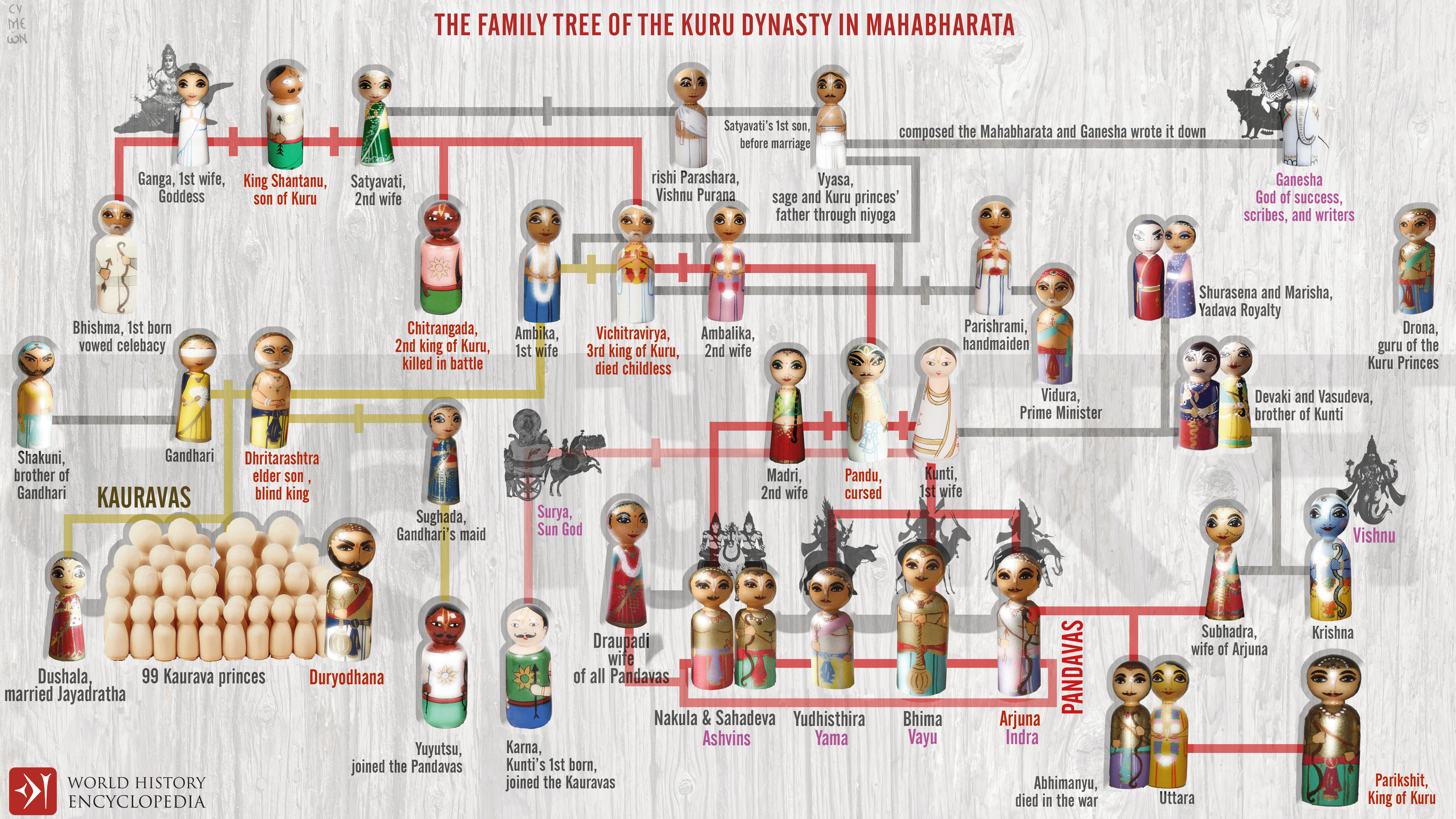“Vishnu came to earth as something more
powerful than himself, Krishna.”
– Dustin Horan
Matsya: The Fish Avatar. King Vaivasvata Manu finds a little fish in the palm of his hands when performing the tarpana (water-offering). The fish asks Manu if his riches and power were enough to give the fish a nice home. Manu keeps the fish to give it a home, but the fish keeps expanding, which breaks Manu’s pride in his wealth. Eventually, he releases it into the ocean, realizing it is Lord Vishnu himself. Vishnu informs Manu of the coming destruction of the world using fires and floods and directs Manu to collect “all creatures of the world” and keep them safe on a boat built by the gods. When the deluge (Pralaya) comes, Vishnu appears as a great fish with a horn, to which Manu ties the boat, which leads them to safety.
Kurma: The Giant Tortoise Avatar. When the devas and asuras were churning the Ocean of Milk to get Amrita, the nectar of immortality, the mount Mandara they were using as the churning shaft started to sink, and Vishnu took the form of a tortoise to bear the weight of the mountain.
Varaha: The Giant Boar Avatar. Jaya and his brother Vijaya are cursed by the sage Sanaka when they stop him from seeing Vishnu and will be reborn three times as demons (asura) to be killed by Vishnu. In their first demonic birth, they become Hiranyaksha and Hiranyakashipu. Varaha appeared to defeat Hiranyaksha, who had taken the Earth, or Bhumi and carried it to the bottom of what is described as the cosmic ocean (much like in ether theory) in the story. The battle between Varaha and Hiranyaksha is believed to have lasted for a thousand years, which the former finally won. Varaha carried the Earth out of the ocean between his tusks and restored it to its place in the universe.
Narasimha: The half-man/half-lion Avatar. Hiranyakashipu persecuted everyone for their religious beliefs, including his son, who was a Vishnu follower. The boy was protected by the god and could not be killed, thus being saved by the several attempts of getting harmed. Vishnu descended as an anthropomorphic incarnation, with the body of a man and the head and claws of a lion. He disemboweled Hiranyakashipu and ended the persecution of human beings, including his devotee Prahlada.
Vamana: The Dwarf Avatar. The grandson of Prahlada, Bali, with devotion and penance, was able to defeat Indra, the god of firmament. This humbled the other deities and extended his authority over the three worlds. The gods appealed to Vishnu for protection, and he descended as a boy Vamana. During a yajna of the king, Vamana approached him, and Bali promised him whatever he asked. Vamana asked for three paces of land. Bali agreed, and the dwarf then changed his size to that of a giant Trivikrama form. With his first stride, he covered the earthly realm. With the second, he covered the heavenly realm, symbolically covering all living beings’ abode. He then took the third stride for the netherworld. Bali realized that Vamana was Vishnu incarnate. In deference, the king offered his head as the third place for Vamana to place his foot. The avatar did so and thus granted Bali immortality and making him ruler of Pathala, the netherworld. Vishnu also granted Bali a boon whereby he could return to earth every year. The harvest festivals of Balipratipada and Onam (mostly celebrated by people of all faiths within Kerala) are celebrated to mark his yearly homecoming. This legend appears in hymn 1.154 of the Rigveda and other Vedic and Puranic texts.
Parashurama: The Warrior Avatar who handled an ax. He is the son of Jamadagni and Renuka and was granted as a boon an ax after a penance to Shiva. He is the first Brahmin-Kshatriya, or warrior-sage, in Hinduism who had to follow the Dharma of both a Brahmin and a Kshatriya. Once, when king Kartavirya Arjuna and his hunting party halted at the ashrama of Jamadagni, the father of Parashurama, the sage was able to feed them all with the aid of the divine cow Kamadhenu. The king demanded the cow, but Jamadagni refused. Enraged, the king took it by force, destroyed the ashram, and left it with the cow. Parashurama then killed the king at his palace and destroyed his army. In revenge, the sons of Kartavirya killed Jamadagni. Parashurama vowed to kill every Kshatriya on earth twenty-one times over and filled five lakes with their blood. Ultimately, his grandfather, Rishi Rucheeka, appeared before him and made him halt. He is a Chiranjeevi (immortal) and is believed to be alive today in penance at Mahendragiri. He is also credited with creating the coastal belt of Karnataka and Kerala by throwing his mighty ax as per Hindu mythology. The place the ax landed in the sea got its water displaced, and the land which emerged thus came to be known as the coast of Karnataka and the whole of Kerala.
Rama: The Avatar of Morality and Rules, The Prince and King of Ayodhya. He is a commonly worshipped avatar in Hinduism and is considered the ideal model of a common prince without superpowers, despite being an incarnation. His story is recounted in one of the most widely read scriptures of Hinduism, the Ramayana. While in exile from his own kingdom with his brother Lakshman and wife Sita, she was abducted by the demon king of Lanka, Ravana. Rama traveled to Lanka, killed the demon king, and saved Sita. Rama and Sita returned home and were crowned. The day of the return of Prince Rama to the kingdom of Ayodhya is celebrated in the festival of Diwali all over India.
Krishna or Balarama:
Krishna was the eighth son of Devaki and Vasudeva and the foster-son of Yashoda and Nanda. A frequently worshipped deity in Hinduism, he is the hero of various legends, particularly the Kansa-vadha and Mahabharata. He embodies qualities such as love, duty, compassion, and playfulness. Krishna’s birthday is celebrated every year by Hindus on Krishna Janmashtami according to the lunisolar Hindu calendar, which falls in late August or early September of the Gregorian calendar. Krishna is usually depicted with a flute in his hand. Krishna is also a central character in Mahabharata, Bhagavata Purana, and the Bhagavad Gita.
Balarama, the elder brother of Krishna, is regarded generally as an avatar of Shesha, an extension of Ananta, a form of Lord Vishnu. Balarama is included as the eighth avatar of Vishnu in the Sri Vaishnava lists, where Buddha is omitted, and Krishna appears as the ninth avatar in this list. He is included in the lists where Krishna is removed and becomes the source of all.
Buddha; sometimes Krishna, Vithoba, or Jagannath.
Gautama Buddha, the founder of Buddhism, is commonly included as an avatar of Vishnu in Hinduism. Buddha is sometimes depicted in Hindu scriptures as a preacher who deludes and leads demons and heretics away from the Vedic scriptures, but another view praises him as a compassionate teacher who preached the path of ahimsa (non-violence).
Krishna; commonly at 8
In Maharashtra and Goa, Vithoba’s image replaces Buddha as the ninth avatar of Vishnu in some temple sculptures and Hindu astrological almanacs.
In certain Odia literary creations from Odisha, Jagannath has been treated as the Ninth avatar by substituting Buddha.
Kalki is the final incarnation of Vishnu, who appears at the end of each Kali Yuga. He will be atop a white horse, and his sword will be drawn, blazing like a comet. He appears when only chaos, evil, and persecution prevails, Dharma has vanished, and he ends the Kali Yuga to restart Satya Yuga and another cycle of existence.




